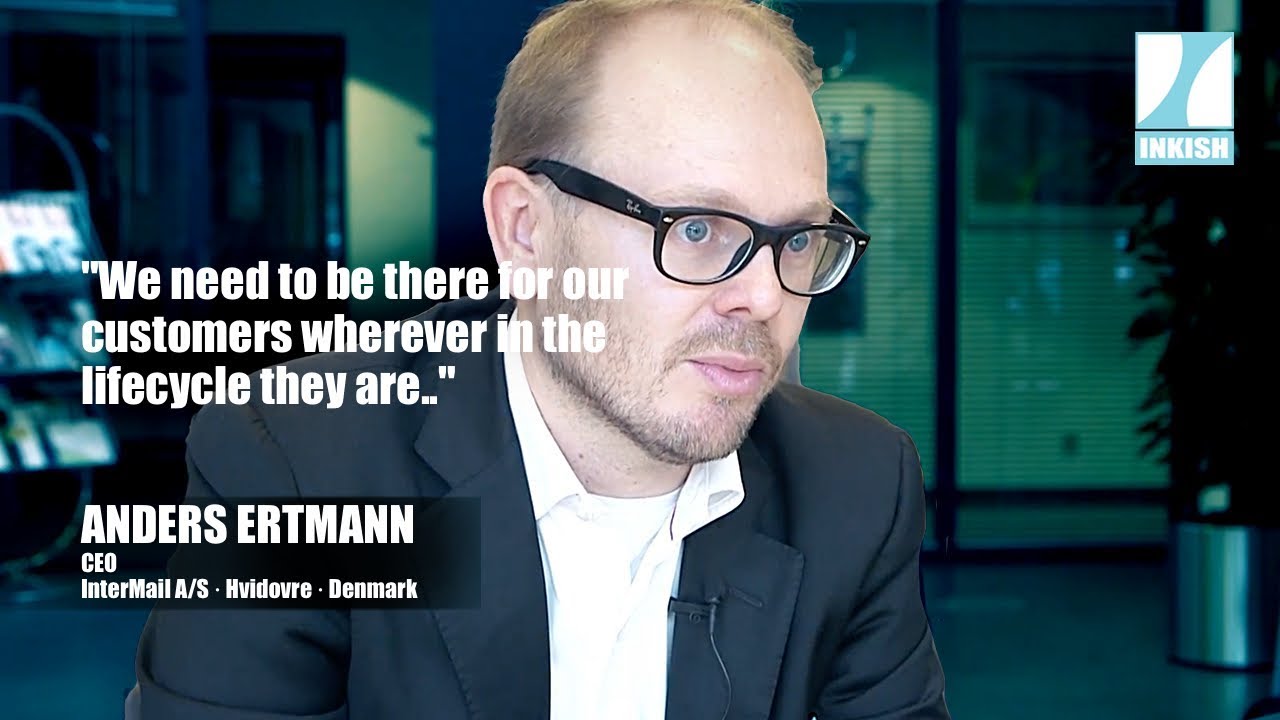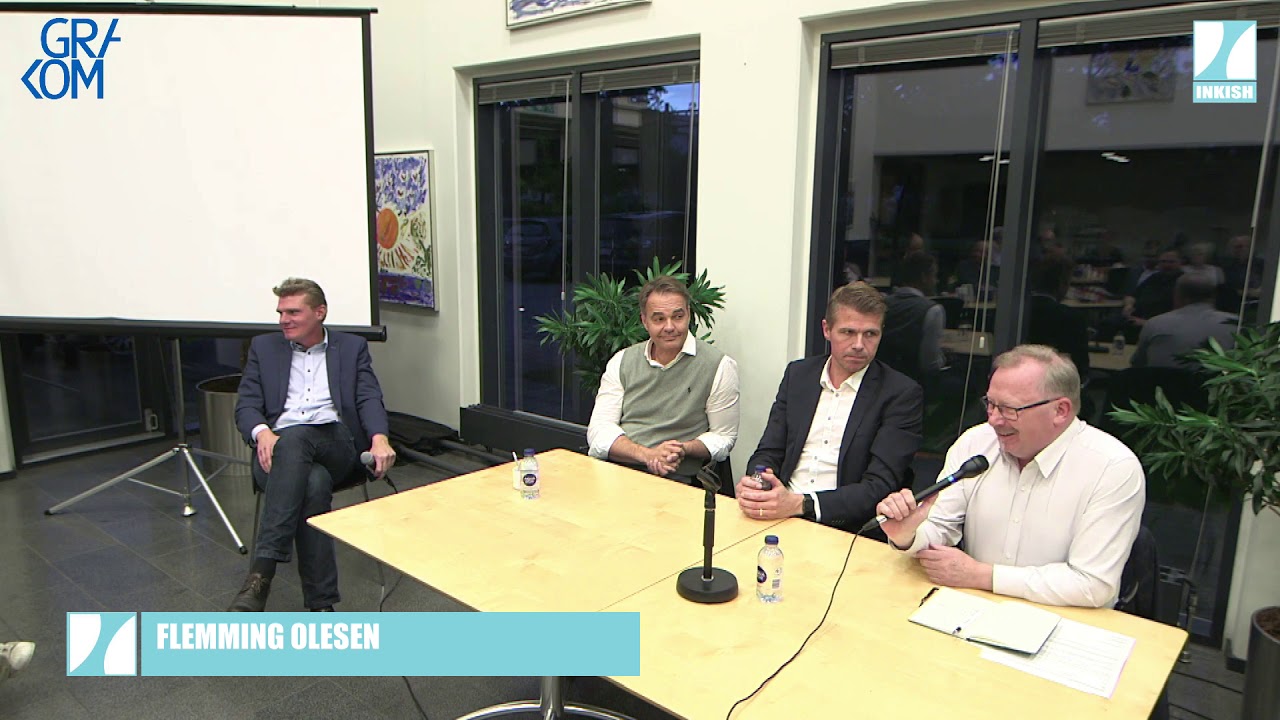INKISH.TV Proudly presents: Anders Ertmann · CEO · InterMail A/S · Hvidovre, Denmark
InterMail has a strong background in the mail, envelope and fulfilment business but is undergoing a lot of changes – from being solely a paper-based supplier to be a leader in Loyalty programs throughout Scandinavia. Actually InterMail has been a company working with digital solutions for more than 20 years – but with the new CEO Anders Ertmann it seems that a lot of changes are in the pipeline and that the company will change over the next years in order to become not only a leader in the business they are well-known for, but also for the business they will conquer.
0:11 With deep roots in the envelope and mailing industry, the Scandinavian company Intermail is working on transforming the company to new products, services and offerings.
0:20 Recently, Intermail got a new CEO Anders Ertmann. With his strong background in financial (as an ex CFO) and a very ambitious and creative mindset, Intermail is working on loyalty programs using both print and electronic communication in its offerings.
0:29 INKISH.TV went to visit Intermail in the suburbs of Copenhagen, Denmark.
0:34 We are a full-service provider of both digital and paper-based communication, and I think that one of the things that we need to change much more going forward is the image. We’ve actually been digital for more than twenty years. We drive the largest customer loyalty group in the Nordic region with Kaplan, more than five million members. So, we are so much more than just being a fulfillment house that produces envelopes. And then, this is the message that we need to get out to the market very fast.
1:08 Does your company have to change or can you continue doing as you always did?
1:13 I think if we were doing what we have done always, we will not be in, in 20 years. We have to do something that is, you know, changing our game. And, I think that’s my main focus going forward for the next couple of years, to change the way. I am in charge, so we’re much more proactive in the way we deal with customers, and that we find the potential that are with the cold customers. We have our own development team sitting in Hvidovre, which have been there for 25 to 30 years. Their skills has also needs to be changed going forward, the way that we sell the products that we have, and also to be much more analytical in the way that we interact with customers using data proactively. So, we will change as an organization going forward. Absolutely.
1:56 A part of that change is that they will focus more on loyalty programs and further develop that side of the business. We asked how do they see this market.
2:06 Accuracy that we have been in the loyalty market for a lot of years. I still see a big, big potential. We have developed a new loyalty program for the smaller business, the S&B market. So, we can actually be in place both for the smaller companies and for the larger companies.
2:20 We are running some of the biggest and most interesting loyalty programs in Nordic region. They are based on our platforms, and we are very proud of that corporation.
2:33 What is a loyalty program?
2:36 A set of initiatives and a technical platform that allows these big retailers to communicate with their customers in a more relevant and meaningful way. We enable the customers. So, for example, Nordic Choice Hotels, to collect data basically from offline, what happens in the hotel, and also online, if somebody books a room online, and some other sources of data obviously. And, collect them and have them in a safe place to be used for all sorts of purposes, but mainly for communication.
3:08 How many details can you gather from a consumer?
3:11 The short question to that answer is that you can take information if you ask them first. So, if you ask a consumer, ìCan I collect this data? And, I’m going to use it for this and this purposeî, then you can collect the data. But, there are also limits, and those limits will also change next year with new law.
3:31 Does data mining and personalization of content work?
3:34 Yes, it does. Because, I think, you know yourself you get a lot of emails, and a lot of them you don’t even read it. I think that when you succeed in making content and context right, then you make me interested. So, we know that for a fact. It helps when you target your customers, and when you make the right communication for the right audience.
4:00 As a retailer today, should you be involved in loyalty programs?
4:04 Yes, absolutely. The marketing departments are looking into this. They are doing rapid changes in how they collect data, how they communicate. And, it might not be that they are calling it a loyalty club, but still they are working with these questions heavily.
4:21 Do you have a loyalty program for your own company and customers?
4:25 Actually, we do. And, we’re taking our own medicine, and so we’re using our own program to look at the loyal customers. Actually, it’s been working much better than I expected. I’ve been very much involved for the last two months in this program, and I’m doing cross selling for customers, and actually finding out what potentials are in the customers to get high up into the value chain.
4:48 How do you measure success in this area?
4:51 Conversion rate is one. And, there are some very popular ways to measure loyalty, and the lifetime value is one of them, and conversion rate is one of them, and frequency is another one, so that you get your customer to come back again and again. And obviously, that is very transaction oriented, but there are also ways to measure their preference if they like you and recommend you to others, which is becoming more and more popular.
5:19 If this brings value to your customers, why is it so difficult to get across?
5:23 You talk about the whole pricing game. Yes, pricing is there. And, it’s to tell the right story to the right people, and it’s to find out where do your project actually give value to the customer. Because then, you don’t talk to them about pricing.
5:39 Selling cycles here are not from day to day right?
5:42 Exactly. Especially when you talk about loyalty programs. There’s a lead time between three to twelve months, before you actually sell a solution. But, there’s a lot to do with the customer in the meantime. And, showing value makes the decision to have a loyalty program much, much faster. So, we need to be there for the customers, wherever they are on the life cycles.
6:03 As a marketing manager, how do you get your customers interested in your products?
6:07 Well, like a lot of other companies, we try to do a lot of inbound marketing. Customers are acting a bit different now than they did some years ago. So now, up to 60% of the progress is already made before the customer contacts the company. So, we try to make white papers and blacks, and do a lot of stuff. So, when the customer are researching the market, then we just pop up with our interesting stuff. So, that’s one of the things we try to do.
6:41 You are personally also known to challenge your audience with your interesting campaigns.
6:44 We try to go to the limit for what you can do with your direct mails, of course, and use the experience we have in this house to make some interesting direct mails, of course.
6:59 Does your history of producing envelopes have any benefits to what youíre doing now with loyalty programs?
7:05 Absolutely. I mean, some of our first customers for those, or Swedish origins, for example, is from the 60s, where we sent envelopes with things to Volkswagen owners. We still do this type of communication in those cases where that suits the customer best. We are totally channel independent, so we use all those channels that you usually hear of, the SMS email, paper-based apps. So, we bring that with us as a historic heritage, which is both fun and interesting when you meet new clients that are only looking into the digital area.
7:41 Why is paper based communication not an obvious choice for distributing loyalty program content if the conversion rates might be bigger?
7:46 I think you need to split the groups that you’re communicating for, because for young people, twenty to thirty years, they want everything digital. But, if you look at plus 50, they are much more likely to have it paper based. So, you need to know much more about your customers to hit them in the right channel, so they get the right message. And, since we have all the data about the customers for twenty years, we should be the one giving good advertising or advice to our customers, and that’s how we will increase our market share going forward.
8:18 And where do you see Intermail in a couple of years?
8:22 Right now, if you look at our revenue, about 15 to 20 percent is digital. Going forward, that should increase a lot. So, it’s 35-40 percent going a couple years forward, but weíll still maintain the base of the quality products we do that are paper based. So, we’ll go more on digital, but weíll not forget our past and our history. We want to grow, and we want to grow both digitally but also paper-based, because I think we don’t have our fair share of the market





































































